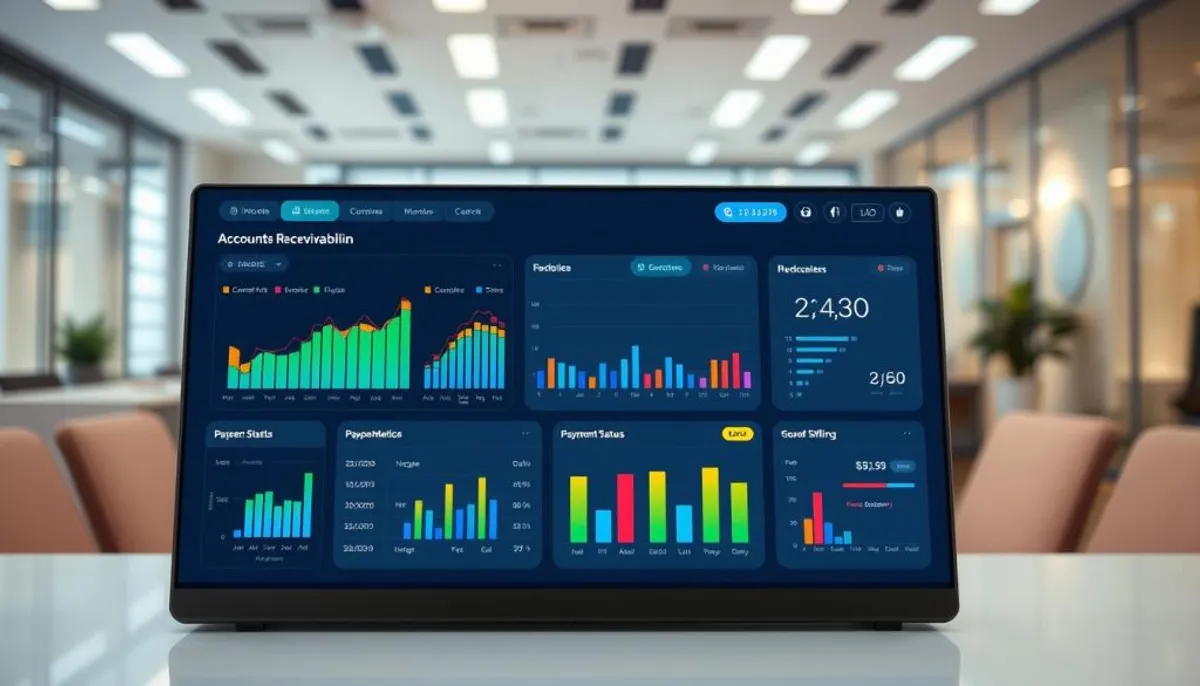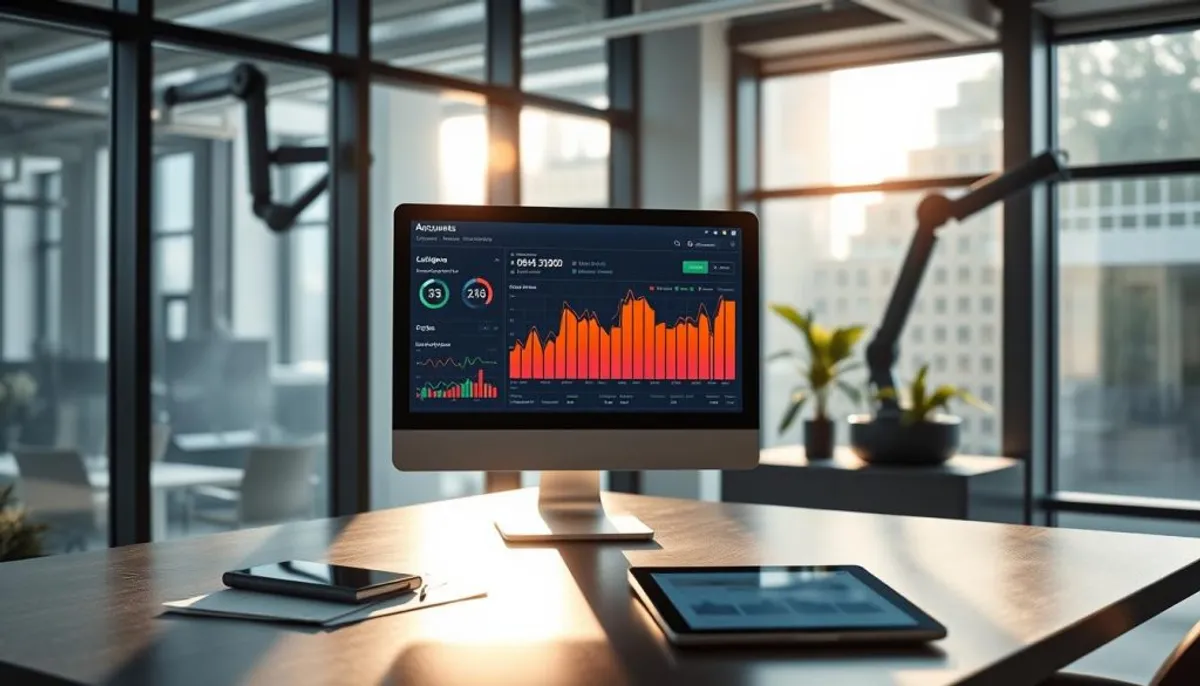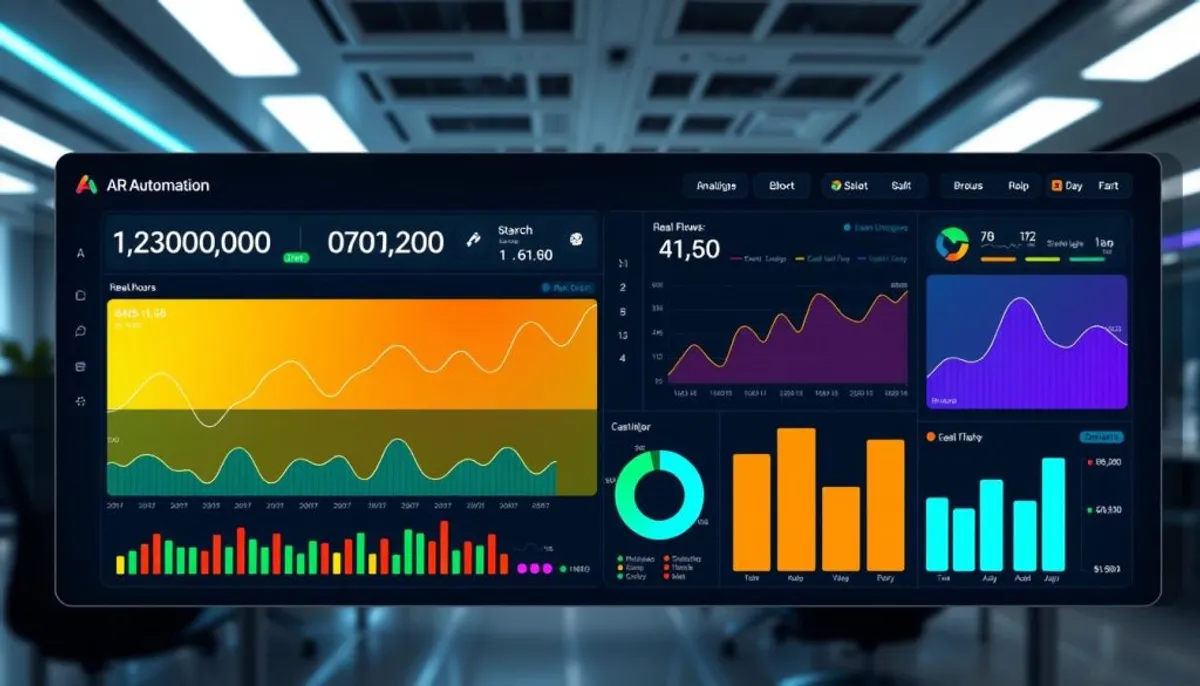In today’s fast-paced business world, managing cash flow is crucial. Account receivable automation offers a game-changing solution for companies looking to boost their financial health. By leveraging AI-powered invoice management and automated payment processing, businesses can significantly improve their bottom line.
AR automation streamlines the entire receivable process, from creating invoices to collecting payments. This modern approach cuts down on manual tasks, reduces errors, and speeds up the cash conversion cycle. For many firms, it’s the key to unlocking better financial stability and growth.

The impact of AR automation is substantial. Mid-sized companies with annual revenues of $250 million or more often struggle with inefficient AR processes. These inefficiencies can lead to manual work on nearly $3.7 million worth of invoices each month. By implementing AR automation, businesses can slash manual work by up to 50% and increase payment speed by 25%.
With 77% of AR teams falling behind on invoice management, the need for a more efficient system is clear. AR automation provides real-time visibility into outstanding invoices, helping to reduce delays and disputes. This improved oversight can lead to a 30% decrease in past-due invoices, directly improving cash flow.
Key Takeaways
- AR automation enhances efficiency and accuracy in financial operations
- It reduces manual work by up to 50% in invoice processing
- Payment speed can increase by 25% with automated systems
- Real-time visibility helps reduce past-due invoices by 30%
- AI-driven insights optimize payment cycles and predict late payments
- Automated systems significantly reduce errors in data entry and processing
Understanding the Importance of Cash Flow Management
Cash flow management is essential for business success. It acts as the lifeblood, ensuring operations run smoothly and facilitating growth. Let’s explore why it’s critical for your company.
Role of Cash Flow in Business Solvency
Effective cash flow management is key to fulfilling financial obligations. It enables companies to reduce days sales outstanding (DSO) by 32%. This leads to quicker access to funds and enhanced financial stability.
Impact on Growth and Investment
Positive cash flow offers the flexibility to invest in new opportunities. It empowers businesses to:
- Acquire new assets
- Expand operations
- Invest in research and development
Operational Stability Factors
Cash flow management significantly influences daily operations. By adopting accounts receivable software and automated invoice capture, businesses can:
- Reduce billing mistakes by 63%
- Save multiple business days each month
- Enhance financial operations efficiency
| Cash Flow Component | Description | Significance |
|---|---|---|
| Cash Flow from Operations (CFO) | Net cash from core business activities | Positive CFO indicates ability to cover ongoing costs |
| Cash Flow from Investing (CFI) | Net cash used for investment activities | Positive CFI suggests reinvesting for growth |
| Cash Flow from Financing (CFF) | Net cash flow from financing activities | Positive CFF may indicate capital raising |
By prioritizing these aspects of cash flow management, businesses can maintain financial health and support sustainable growth.
Account Receivable Automation: A Modern Solution
AR automation is transforming financial management. It leverages invoice processing automation and intelligent document processing to enhance receivables management. This innovation is a paradigm shift for enterprises aiming for operational excellence and precision in their financial dealings.
The effects of AR automation are profound. It can significantly reduce invoicing expenses by more than 70% by transitioning from paper to digital formats. It also eliminates the need for manual data entry, allowing staff to engage in more strategic activities. This transformation empowers businesses to concentrate on expansion rather than administrative tasks.
AR automation provides real-time analytics for executives. It enables them to monitor process performance and productivity metrics continuously. This capability aids in identifying areas for improvement and enhancing financial health. It is indispensable for CFOs, who now play a more strategic role in their organizations.
| Traditional AR Process | Automated AR Process |
|---|---|
| Manual invoice generation | Automated invoice creation |
| Paper-based tracking | Digital payment tracking |
| Manual reminders | Automated payment reminders |
| Time-consuming reporting | Instant report generation |
Implementing AR automation enables businesses to expedite processing times and diminish human errors. It optimizes tasks such as invoice generation, payment tracking, and collections management. This efficiency results in quicker payment cycles and enhanced cash flow.
Current Challenges in Traditional AR Processes
Traditional accounts receivable (AR) processes are beset by significant hurdles, affecting business efficiency and cash flow. Many companies persist with outdated methods, resulting in a myriad of issues that impede financial operations.
Manual Processing Limitations
Manual invoice processing is a major bottleneck in AR workflows. An astonishing 98% of C-level executives report that upper management is overwhelmed with invoice disputes and payment issues. This antiquated approach not only hampers the entire process but also escalates the risk of errors.
Time and Resource Constraints
Time-consuming tasks inherent in traditional AR processes strain company resources. 40% of finance leaders identify manual processes as the primary obstacle in collecting payments. This inefficiency often results in delayed receivables, negatively impacting overall cash flow management.
Error-Prone Operations
Human errors in manual data entry can lead to inaccurate invoices, potentially harming business relationships and reputation. These mistakes can precipitate disputes, delayed payments, and additional efforts to rectify issues.
| Challenge | Impact | Solution |
|---|---|---|
| Manual Processing | Slow, error-prone operations | Accounts receivable workflow automation |
| Resource Strain | Delayed payments, poor cash flow | Streamlined digital processes |
| Inaccurate Invoicing | Disputes, damaged relationships | Touchless invoice processing |
Adopting accounts receivable workflow automation and touchless invoice processing can mitigate these challenges, enhancing efficiency and accuracy in AR operations. By embracing digital solutions, businesses can transcend the limitations of traditional methods and refine their financial processes.
Introducing ti3: Your AR Management Solution
ti3 represents a groundbreaking SaaS platform, aimed at transforming account receivable automation. It simplifies the AR process, providing businesses with an efficient means to manage their accounts and enhance cash flow.
Platform Overview and Features
ti3’s interface is designed for ease of use, making AR management straightforward. It features automated invoice processing, which significantly reduces errors and shortens processing times. The platform also supports electronic invoicing, resulting in substantial cost savings by eliminating paper and mailing expenses.

Automated Reminder System
ti3’s automated reminder system stands out as a key feature. It sends timely reminders to customers, effectively lowering the incidence of late payments. Given that 33% of SMEs face delays of over two months in receiving overdue invoices, ti3’s system can be transformative for businesses facing cash flow challenges.
Payment Collection Capabilities
ti3 shines in automated payment processing, offering diverse payment options to customers. This flexibility, coupled with clear invoice due dates, significantly increases the likelihood of on-time payments. The platform’s effective collection capabilities can mitigate the $909,506 monthly losses mid-sized companies incur due to late payments.
| Feature | Benefit |
|---|---|
| Automated Invoice Processing | 66% reduction in errors |
| Electronic Invoicing | 60-80% cost reduction |
| Automated Reminders | Reduced late payments |
| Flexible Payment Options | 8x increase in on-time payments |
Key Benefits of Automated AR Systems
Automated accounts receivable software offers numerous advantages to businesses facing challenges with traditional AR processes. These systems significantly alter how companies manage their cash flow and interact with customers.
AI-powered invoice management greatly enhances operational efficiency, resulting in significant time and cost savings. A Forrester study found that AR automation saves 35,000 administrative hours annually. This efficiency enables finance teams to concentrate on strategic tasks, rather than routine duties.
Another critical benefit is the improvement in accuracy. Manual processes often introduce errors, but automation significantly reduces these. This precision can lead to annual savings of $4.9 million in consumer bad debt, enhancing any company’s financial health.
Enhanced customer experience is a significant advantage of AR automation. In fact, 97% of C-level executives deem it essential in AR processes. Automated systems offer various payment options and expedite invoice processing, resulting in higher customer satisfaction.
| Benefit | Impact |
|---|---|
| Time Savings | 35,000 administrative hours saved annually |
| Cost Reduction | $4.9 million potential savings in bad debt |
| Customer Satisfaction | 97% of executives consider it crucial |
| Invoice Processing | 77% reduction in delays |
Lastly, accounts receivable software provides valuable insights through real-time analytics. This data empowers businesses to make informed decisions, optimize payment cycles, and enhance collections management. Ultimately, this leads to better cash flow and financial stability.
Essential Components of AR Workflow Automation
AR workflow automation is transforming the financial management landscape for businesses. It streamlines operations, enhances efficiency, and improves the accuracy of accounts receivable processes.
Invoice Generation and Processing
Invoice processing automation is a transformative technology for businesses. It minimizes manual labor and accelerates the billing cycle. Companies can process over 20,000 invoices monthly and receive payments in just 55 days, compared to 78 days without automation.
Payment Tracking Systems
Automated payment tracking systems provide real-time insights into customer payment behaviors. This feature enables businesses to manage their cash flow more effectively. For instance, Stripe reports that most of their invoices are settled in less than three days, highlighting the efficiency of payment tracking.
Reconciliation Automation
Reconciliation automation significantly reduces financial discrepancies. It ensures data consistency across invoices and payments, leading to fewer errors and increased accuracy. This automation allows finance teams to focus on more strategic tasks, enhancing overall productivity.
| AR Automation Component | Key Benefit | Impact |
|---|---|---|
| Invoice Processing | Faster Payment Cycles | 23 days reduction in average payment time |
| Payment Tracking | Improved Cash Flow Management | 3-day average settlement time |
| Reconciliation | Increased Accuracy | Significant reduction in financial discrepancies |
By integrating these essential components, businesses can revolutionize their AR processes. This leads to improved cash flow and operational efficiency.
Integration Capabilities and System Requirements
Accounts receivable workflow automation is revolutionizing financial management in businesses. For optimal utilization, your AR automation solution must integrate flawlessly with current systems. This integration facilitates smooth data exchange, minimizing manual input and errors.
When evaluating an AR automation platform, assess its compatibility with your existing accounting software, ERP systems, and CRM platforms. Opt for solutions with robust integration capabilities to enhance your financial workflows.
Intelligent document processing is a critical feature in AR automation systems. This technology can decipher various document formats, extract pertinent data, and process it accurately. It’s vital for efficiently handling diverse invoice types and formats.
| System Requirement | Importance |
|---|---|
| Integration with existing software | Essential for seamless data flow |
| Scalability | Adapts to growing business needs |
| Multi-currency support | Manages international transactions |
| Mobile accessibility | Enables on-the-go AR management |
Opting for an AR automation solution with superior integration capabilities can dramatically enhance your financial operations. This results in faster processing times, fewer errors, and superior cash flow management.
Real-Time Analytics and Reporting Features
AR automation software transforms financial management with its advanced real-time analytics and reporting capabilities. These tools offer immediate insights into essential performance metrics. This empowers businesses to make informed decisions and optimize their cash flow.
Performance Metrics and KPIs
Automated payment processing systems monitor critical KPIs such as Days Sales Outstanding (DSO) and cash application rates. This real-time data enables finance teams to detect trends, identify issues, and promptly take action to enhance AR efficiency.
Financial Intelligence Dashboard
A comprehensive dashboard provides an instant overview of vital financial information. It offers a clear view of your AR status, including outstanding invoices, payment trends, and cash flow projections. This clarity aids in strategic planning and resource allocation.
Customizable Reports
Touchless invoice processing systems offer customizable reporting options. Users can design reports tailored to specific aspects of their AR process, such as customer payment behaviors or collection effectiveness.

| Feature | Benefit |
|---|---|
| Real-time KPI tracking | Quick identification of AR performance issues |
| Interactive dashboards | Improved visibility into financial health |
| Customizable reports | Focused analysis for informed decision-making |
| Automated data collection | Reduced manual errors and time savings |
By utilizing these advanced analytics and reporting features, businesses can streamline their AR processes. This leads to better cash flow management and overall financial performance.
Security and Compliance in AR Automation
AR automation introduces robust security measures to safeguard sensitive financial data. Implementing stringent security protocols is essential for businesses to protect their financial information. This is critical in today’s digital environment, where cyber threats are rampant.
Intelligent document processing within account receivable automation significantly enhances data security and privacy. It is imperative for adhering to data protection laws and regulations. Automation software limits access to sensitive financial data and employs encryption, thus drastically reducing the risk of data breaches.
Compliance is another pivotal advantage of AR automation. It aids organizations in regulated sectors in fulfilling stringent requirements. Here’s how:
- Eliminates manual data entry, reducing errors in financial reporting
- Provides a complete audit trail and real-time reporting for transparency
- Streamlines internal processes, improving efficiency and reducing fraud risk
- Enables prompt and accurate responses to audits and regulatory inquiries
The impact of AR automation on security and compliance is profound:
| Metric | Impact |
|---|---|
| Credit controller coverage | 33% improvement |
| Team productivity | Over 50% increase |
| Payment speed | 20-30% increase |
| Bad debts | Decrease |
| Cash flow | More predictable |
By adopting account receivable automation, businesses can ensure compliance, bolster security, and make informed financial decisions. This results in enhanced financial health and operational efficiency.
Cost-Effectiveness Compared to Traditional Collection Methods
AR automation significantly reduces costs compared to traditional collection methods. Accounts receivable software optimizes processes, lowering labor expenses and errors while enhancing cash flow. Let’s examine the financial advantages of adopting automated invoice capture systems.
ROI Analysis
Investing in AR automation offers substantial returns. Companies employing automated systems report notable enhancements:
- 25% reduction in past-due deliverables
- 20% reduction in days sales outstanding (DSO)
- 15% reduction in bad debt reserves
These improvements equate to tangible financial benefits, positioning AR automation as a prudent investment for businesses across various scales.
Resource Allocation Benefits
AR automation liberates staff time from manual invoice processing. Employees can then engage in strategic tasks, enhancing productivity and job satisfaction. This shift also diminishes errors inherent in manual processes.
| Plan | Price | Capacity |
|---|---|---|
| Sole Proprietor | $49/month | Up to 100 open invoices |
| Small Business | $99/month | Up to 500 open invoices |
| Enterprise | $199/month | Unlimited invoices |
Long-term Financial Impact
The long-term advantages of AR automation are profound. Enhanced cash flow management, reduced DSO, and diminished bad debt reserves bolster financial health. The integration of accounts receivable software with existing systems also offers valuable insights for informed decision-making.
Compared to outsourcing AR, which can range from $500 to $7,000 monthly, AR automation presents a cost-effective alternative. With plans beginning at $49/month and potential savings of up to 20% for annual subscriptions, businesses can markedly reduce expenses while boosting efficiency.
Implementation Strategy and Best Practices
Embarking on the journey of accounts receivable workflow automation necessitates meticulous planning and execution. A successful implementation paves the way for expedited, precise transaction processing and enhanced working capital. Let’s dissect pivotal strategies and best practices for a seamless transition to automated AR systems.
Initiate by evaluating your current processes and articulating clear objectives. Select an invoice processing automation solution that harmonizes with your existing accounting software. This foundational step is essential for a unified financial ecosystem.
Effective change management is paramount. Educate your team on the advantages of AR automation and offer comprehensive training. User acceptance testing is vital to uncover and rectify potential issues promptly.
- Implement automated invoice generation and delivery
- Set up electronic payment solutions for streamlined transactions
- Configure automated payment matching systems
- Establish robust security measures like encryption and multi-factor authentication
Post-implementation, it is imperative to monitor key performance indicators (KPIs) to verify the system’s alignment with your organization’s objectives. Track metrics such as Days Sales Outstanding (DSO) and aging reports to proactively enhance AR performance.
| Benefit | Impact |
|---|---|
| Increased Productivity | Consistent and reliable data management |
| Improved Customer Experience | Accurate payment processing and tracking |
| Enhanced Sales Efforts | Creation of accurate customer profiles |
| Informed Treasury Operations | Accurate monitoring of payment behaviors |
A smoothly operating AR system functions unobtrusively, with teams rarely notified of issues. This “quiet operation” signifies successful implementation and sustained efficiency in your accounts receivable workflow automation.
Conclusion
Account receivable automation is transforming financial operations across various business scales. The integration of AI in invoice management is pivotal, significantly boosting cash flow and operational efficiency. The trend towards digital solutions is evident, with midsize organizations leveraging over 110 SaaS applications.
The advantages of AR automation are profound. Teams can save up to 60 hours weekly on invoice management, thanks to automated billing reminders and diverse payment options. This streamlined process not only minimizes late payments but also fosters a more predictable cash flow. The seamless integration of CRM and accounting software ensures real-time data exchange, enhancing team alignment and reducing errors.
Despite initial reservations about security, affordability, and the steep learning curve, businesses are discovering AR automation to be more accessible and user-friendly than expected. With over two decades of experience in electronic supply chain solutions, the industry has perfected these tools. They are now customizable and adaptable to meet specific business requirements. As we progress, embracing account receivable automation and AI-powered invoice management will be essential for businesses seeking to stay competitive in the dynamic financial environment.
RelatedRelated articles



